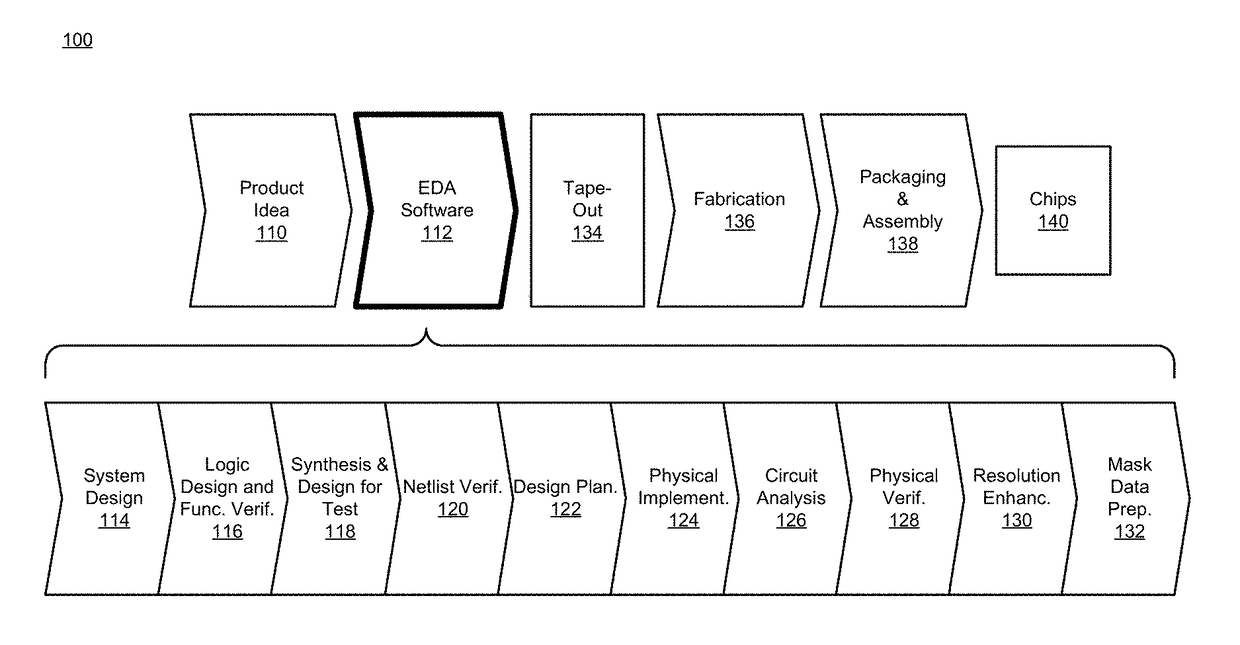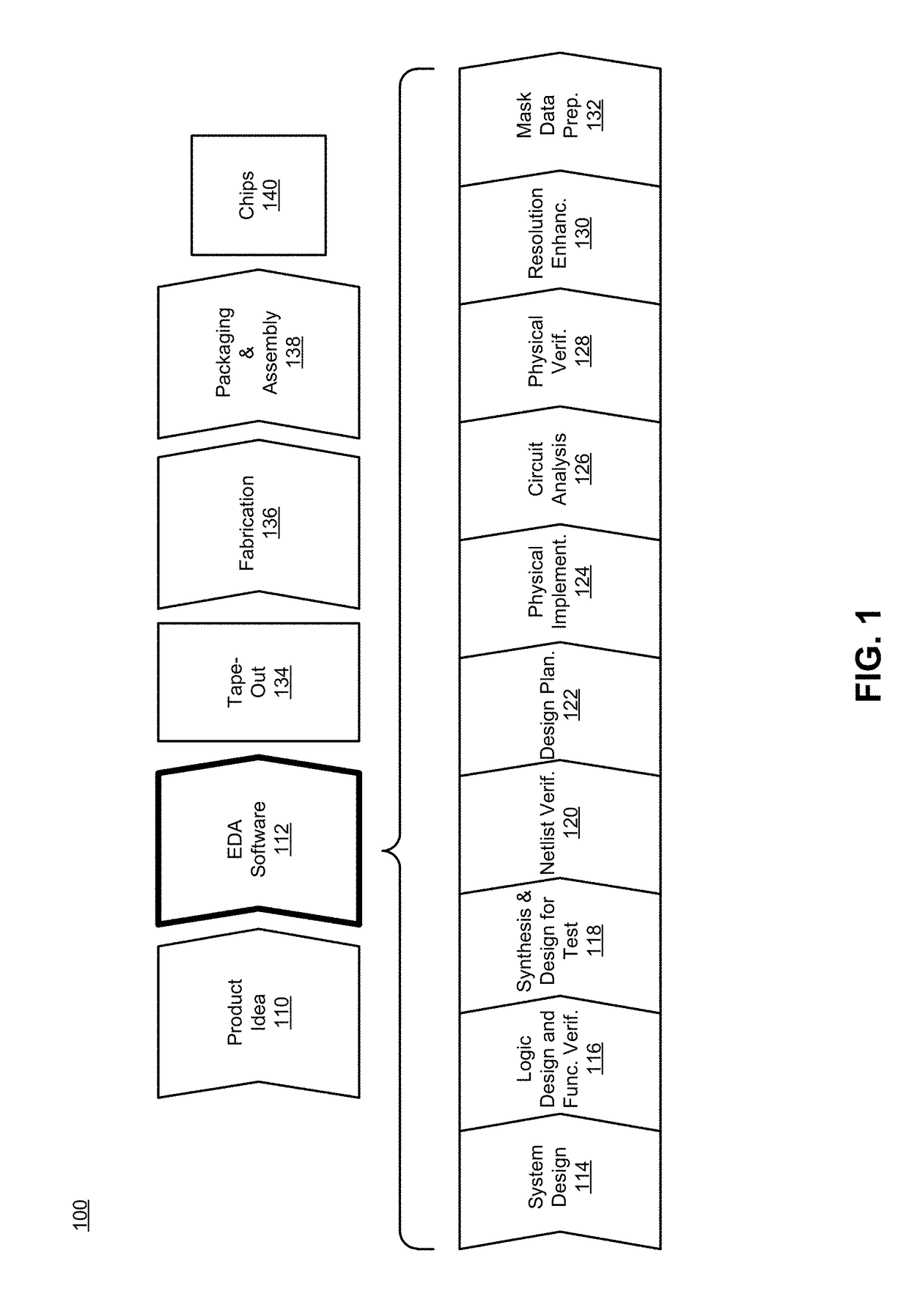Creating and Reusing Customizable Structured Interconnects
a structured interconnect and design technology, applied in the field of reusable custom structured interconnect designs, can solve the problems of reducing the design quality of the structure, requiring significant adjustments that are similar time-consuming, and rarely achieving the optimal of the batch router, so as to save the designer's time and improve the design
- Summary
- Abstract
- Description
- Claims
- Application Information
AI Technical Summary
Benefits of technology
Problems solved by technology
Method used
Image
Examples
example 400b
[0064]Example 400b of FIG. 4B illustrates a {fishbone} structure, which is characterized by tap-offs extending from both sides of the trunk. Like in example 400a, tap-offs 402 extend downward from the four top pins and connect to a single trunk 410 in the middle channel. However, unlike in example 400a, tap-offs 406a and 406b of the bottom pins extend upward from the four bottom pins into the middle channel and connect to the same trunk 410 that the top pins are connected to. Trunk 410 has tap-offs extending from both sides to connect to pins on both the top row and the bottom row, and thus would be described by the structural directive {fishbone}.
[0065]Example 400c of FIG. 4C illustrates an {intermittent} modification to a {backbone} structure. The {intermittent} modification is characterized by definition of the number and placement of the trunks based on groups of adjacent pins. The connections of the top pins of example 400c match those of example 400a, but the connections of th...
first embodiment
[0077]FIG. 6A illustrates a schematic 600 of a portion of an IC, and FIG. 6B is a connectivity diagram of a physical representation corresponding to the schematic 600, according to a The schematic 600 includes two transistors 602 and 604, with the gate connection 606 of transistor 602 highlighted to indicate that it is the connection to which the connection layout corresponds. The connectivity diagram of FIG. 6B is a visual representation of four rows of pins that are separated by first, second, and third channels, respectively. Line 620 reflects the connectivity information and indicates that pins 610, 612a, 612b, 614a, 614b, and 616 are to be connected. These pins have been darkened to distinguish them from pins that do not need to be connected in this example.
[0078]FIG. 6C is a custom connection layout 650 corresponding to the connectivity diagram of FIG. 6B, according to the first embodiment. In the first row, tap-offs 652a extend downward from the three leftmost pins 610 to co...
second embodiment
[0080]FIG. 7A is a schematic 700 of a portion of an IC, and FIG. 7B is a connectivity diagram corresponding to a physical implementation of schematic 700, according to a The schematic 700 includes two transistors 602 and 604, with the gate connection 706 of transistor 604 highlighted to indicate that it is the connection for which the connection layout is being designed. The connectivity diagram of FIG. 7B is a visual representation of four rows of pins that are separated by first, second, and third channels, respectively. Line 720 reflects the connectivity information and indicates that pins 710a, 710b, 712, 714, 716a and 716b are to be connected. These pins have been darkened to distinguish them from pins that do not need to be connected in this example.
[0081]FIG. 7C is a custom connection layout 750 corresponding to the connectivity diagram of FIG. 7B, according to the second embodiment. In the first row, tap-offs 752a extend downward from the three leftmost pins 610a to connect...
PUM
 Login to View More
Login to View More Abstract
Description
Claims
Application Information
 Login to View More
Login to View More - R&D
- Intellectual Property
- Life Sciences
- Materials
- Tech Scout
- Unparalleled Data Quality
- Higher Quality Content
- 60% Fewer Hallucinations
Browse by: Latest US Patents, China's latest patents, Technical Efficacy Thesaurus, Application Domain, Technology Topic, Popular Technical Reports.
© 2025 PatSnap. All rights reserved.Legal|Privacy policy|Modern Slavery Act Transparency Statement|Sitemap|About US| Contact US: help@patsnap.com



